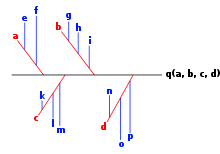Graphic organizer
A graphic organizer, also known as a knowledge map, concept map, story map (or storymap), cognitive organizer, advance organizer, or concept diagram, is a communication tool that uses visual symbols to express knowledge, concepts, thoughts, or ideas, and the relationships between them.[1] The main purpose of a graphic organizer is to provide a visual aid to facilitate learning and instruction.[1][2]
Forms
Graphic organizers take many forms:

Ishikawa's Cause & Effect diagram (fishbone chart)
- Relational Organizers
- storyboard
- fishbone -- Ishikawa diagram
- cause and effect web
- chart
- #Category/Classification Organizers
- Sequence Organizers
- Chain
- Ladder
- Cycle
- Compare Contrast Organizers
- Concept Development Organizers
- story web
- word web
- circle chart
- flow chart
- Options and Control Device Organizers
Enhancing students' skills
A review study concluded that using graphic organizers improves student performance in the following areas:[3]
- Retention
- Students remember information better and can better recall it when it is represented and learned both visually and verbally.[3]
- Reading comprehension
- The use of graphic organizers helps improving the reading comprehension of students.[3]
- Student achievement
- Students with and without learning disabilities improve achievement across content areas and grade levels.[3]
- Thinking and learning skills; critical thinking
- When students develop and use a graphic organizer their higher order thinking and critical thinking skills are enhanced.[3]
See also
References
- 1 2 "Instructional Strategies Online - Graphic Organizers {waves}". Olc.spsd.sk.ca. 1999-01-01. Archived from the original on 2013-03-10. Retrieved 2012-10-13.
- ↑ Compare: "50 Uses of Graphic Organizers and Rubric". University of Wisconsin Stout: School of Education. University of Wisconsin. Retrieved 2016-08-12.
- 1 2 3 4 5 Graphic Organizers: A Review of Scientifically Based Research, The Institute for the Advancement of Research in Education at AEL
External links
This article is issued from
Wikipedia.
The text is licensed under Creative Commons - Attribution - Sharealike.
Additional terms may apply for the media files.